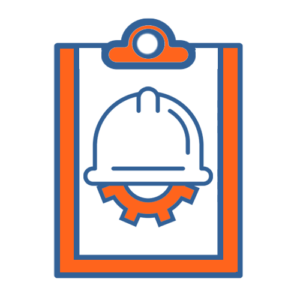Why You Need to Create a “Digital Twin” to Succeed in Manufacturing Marketing
Marketing has long been an afterthought in the manufacturing world. This is the realm of the salesperson, thanks to their product expertise and technical knowledge.
But now prospects are searching for product and service answers online. And if you’re not there, your competitors will be.
Replacing your sales team isn’t the answer. Instead, recreate their expertise online with our Digital Twin marketing approach. The sections below provide the blueprint, starting with the Digital Twin Manufacturing Marketing Strategy.

1. The Digital Twin Manufacturing Marketing Strategy

2. How to Use Content Marketing to Create a Digital Twin

3. Making Your Content Fit in the Manufacturing Customer Journey
![]()
4. SEO for Manufacturers: From smoke and mirrors to clear-cut strategy
![]()
5. Email Strategy for Your Manufacturing Marketing

6. Measuring Marketing Effectiveness

Part 1: The Digital Twin Manufacturing Marketing Strategy
In manufacturing, when a machine or manufacturing process is recreated digitally, it’s called a “Digital Twin.” The Digital Twin is then used for rapid prototyping, experimenting with the use of different materials, and a variety of other simulated manufacturing processes.
But the concept is not restricted to the manufacturing floor. Because so many customers are searching for answers online, marketing must also create a Digital Twin, but not of a machine or a process. You need a Digital Twin of your sales team.
Before we dive deeper into what the Digital Twin Strategy entails, let’s take a look at the challenges that necessitate the approach.
The Four Eternal Marketing Challenges of Manufacturers (and One Digital Newcomer)
Buying a million-dollar piece of equipment is a whole different ball game than shopping for a new pair of shoes. It’s why manufacturing marketing poses a unique set of challenges, including four that have been with us since manufacturing began, and one new kid on the block.

1. You have many customers to reach and different “languages” to understand
Manufacturing marketers have a number of different personas they’re trying to reach, all of whom have different priorities, agendas or even languages.
Jagdish Sheth, a Professor of Business at Emory University, identifies three individuals involved in different phases of the buying process (their departments are in parentheses):
- Purchasing agents (purchasing)
- Engineers (quality control)
- Users (manufacturing department)
An industrial marketer must be able to communicate in the language of each of these different job positions. For example, an engineer might be focused on product specs, while purchasing might be looking at product cost, service packages, etc.

2. Your prospects have multiple objectives
The next hurdle is the criteria for purchase. For that, Prof. Sheth breaks down “explicit” and “implicit” objectives.
The “explicit” objectives are product-related. We’d consider these more rational / logical in nature. What’s the delivery time? The price?
The “implicit” objectives are related to your company, and they are emotional. They involve your reputation, your relationships within the industry — essentially your brand.
Explicit objectives
(related to the product):
Product quality
Delivery time
Quantity of supply
After-sale service
Price
Implicit objectives
(related to company):
Reputation
Size
Location
Reciprocity relationship with the supplier
Salesperson (personality, technical expertise, salesmanship)
There is considerable debate over which objective is more important in the sales process. Research by Field and Binet indicates brand actually weighs more heavily in B2B sales. And neuroscience tells us that humans buy based on emotion, not logic. These are implicit objectives.
Those might be what ultimately cause the decision, but you need the explicit objectives to get the ball rolling.

3. Your products and services are complex
Your products tend to be complex, and require a great deal of technical knowledge to explain and sell.
This poses a problem for marketers, who typically aren’t engineers or technicians. To overcome the knowledge gap, most companies will train engineers and technicians on the Xs and Os of sales and marketing, not the other way around.
Yet someone who is naturally inclined toward the technical aspects (explicit objectives, from above), might overlook the all-too-valuable implicit objectives. To mix a few metaphors, if you get too deep into the weeds, you miss the forest for the trees.
That’s where the marketer, who is more skilled in drawing out the story and appealing to the emotional elements, will excel.

4. You have lengthy sales cycles
Considering all the people who need to be appeased, and all the objectives that need to be fulfilled, is it any wonder that manufacturers deal with extended sales cycles?
We’re surprised it isn’t even longer. In a 2018 report from Miller Heiman Group, nearly 75% of companies report a sales cycle greater than 4 months, with just over 18% of those reporting cycles over 12 months.
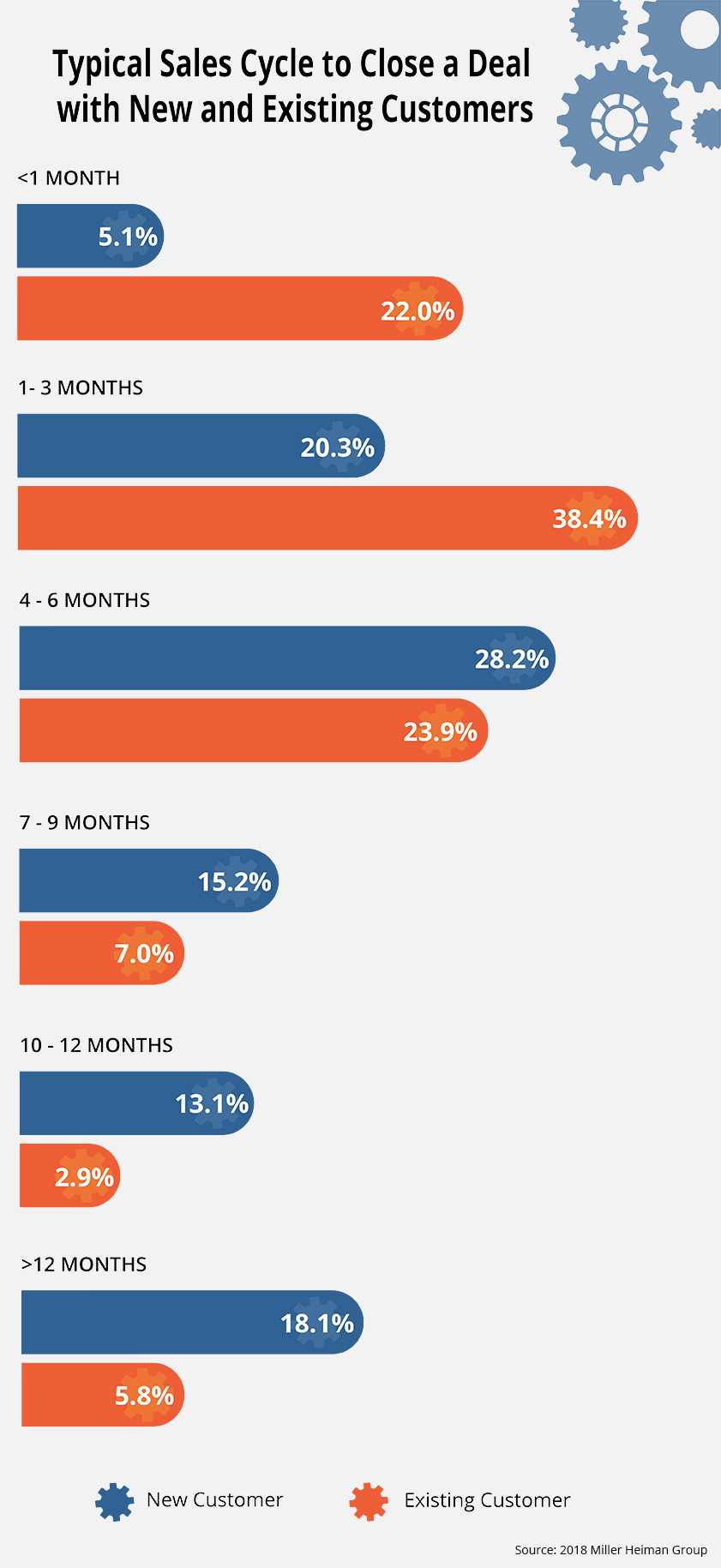
There are other complexities to wrangle with — e.g., lack of marketplace research, demand for customized solutions, the need for brand building. But for marketers, the four challenges we’ve just listed are the most prominent, and your marketing should always address them.
But what’s changed is the emergence of a new kid on the block: the digital challenger.
The new digital challenge: Your customers are shopping online
The manufacturing industry values its salesperson as much or more than any other vertical, primarily because of the four eternal challenges.
What’s changed, however, is the prequalification process. Customers are now performing more of the prequalification themselves.
Check out some of the research about B2B buyers, which we find to be consistent with manufacturers:
- 70% of buyers fully define their needs on their own before engaging with a sales representative (CSO Insights)
- 44% identify specific solutions before reaching out to a seller (CSO Insights)
- 67% of the buyer’s journey is now done digitally (Sirius Decisions)
Now don’t get us wrong, the salesperson still plays a critical role. After all, 65% of B2B buyers said that they found value in discussing their situations with salespeople (CSO Insights).
It’s not like a prospect is going to hit “Add to Cart” on a multi-million dollar purchase. But there’s no denying that customers are asking many of their questions online. And it’s up to you to use your content to answer them.
The Digital Twin Marketing Strategy for Manufacturers Follows a Simple Equation: Content + Marketing = Success
Now that you understand why you need to create a Digital Twin of your sales team, let’s look at how you’re going to do it.
It starts with content marketing.
Content marketing is not a buzzword. In today’s marketing vernacular, it’s using content to draw people to your company and your website. But think of it in the context of creating a Digital Twin:

Content
recreates what the salesperson says to prospects.
(Content = Digital Twin Talking)

Marketing
recreates how the salesperson delivers that message to prospects.
(Marketing = Digital Twin Prospecting)
By taking a content marketing approach in this way, your digital twin will deliver on a number of fronts, including:
- Being there when customers are using search engines to ask questions that your product or service can solve.
- Providing valuable tools to help prospects solve those problems.
- Sharing data and customer feedback to help assure prospects that you have the right solution.
- Helping you generate referrals.
This is the overall strategy, now we’ll get into specifics in our next section.

Part 2: How to use Content Marketing for Manufacturers to Create a Digital Twin of Your Sales Team
As we mentioned in the last section, let’s break down content marketing into two areas: content and marketing.
Content: Strategic uses for your Digital Twin
When we say you should create a Digital Twin of your salesperson, we’re not suggesting it as a replacement for your sales team. Instead, it should function in a complementary manner:

Use SEO content for when your customer is searching online
It’s an on-demand world. You need to operate in it. By creating content optimized for different points in the customer journey, you’re allowing the customer to discover solutions when they search for it.
From top-of-the-funnel content that will appear on your blog, to your sales / landing pages that appear on your website, your content should be optimized for every stage of the customer journey. (We’ll dive deeper into this area in the next section.)

Use social media content to build connections, aka, referrals
If you think of social media, especially LinkedIn, as a place to push sales, then you’re dead in the water. For example, how many times have you received LinkedIn invites from complete strangers who are just spamming you for business like they spam countless others?
Instead, think of social media as a place to find potential referral sources, and you’ll succeed. Despite all the talk of lead generation coming from online, more leads to your business come via your sales team.

Use email content to stay in touch with your customers and cultivate prospects
How many leads have been collected by your sales team, only to never be contacted again? How about those customers who slowly drift off the radar?
Your sales team can’t possibly stay in touch with all of them. Using email, you can share relevant content and stay in their in-box and on their minds.

Use video content to create personal connections
From short, informal social media videos to more polished corporate videos, you can amplify your real sales team and put a face to all your messaging. Video can also include webinars and online conferences. Video is a tremendous way to make personal connections.
Industrial Content Marketing Pro Tip:
Make sure your content is backed by data to add credibility and make your sales team more efficient.
If your sales team makes a claim, that’s not enough. People want the data to back it up.
According to research by SurveyMonkey, 75% of people said data-backed content was more trustworthy than content without data, and 73% said it was more persuasive.
They want detailed product information verified by external sources or your own proprietary research. If you say it without data to back it up, then it just sounds like you’re selling.
Marketing: Helping your Digital Twin reach prospects
The “marketing” component of content marketing is how you distribute your content. It’s absolutely mission critical. Producing content just for content’s sake won’t get you found. You need to deliver it to the people who want to see it.
Time for your Digital Twin to channel surf.
This involves choosing the right channels, and using the correct messaging that’s appropriate.
Organic channels to distribute content and build audience
These channels don’t necessarily cost money to use, but they do take time and will respond only with the amount of effort you put into them. Think of organic channels as networking events: You get out what you put in.

Social Media
As your company and your individual sales team builds followers and connections through tools like LinkedIn, you expand your reach and meet potential referral sources. Don’t look for social media to generate leads; use it to build brand and relationships.

Search Engine Optimization
Everyone searches for answers, and there are keywords your content needs to rank for through the customer journey. From informative terms to transactional terms, when people search for these, you need to be found. As your content begins to rank for keywords, your traffic can grow exponentially.

Email addresses are your Digital Twin’s rolodex. Use your list to cultivate new followers and keep in touch with customers. The bigger your list, the larger your audience. You can effectively segment your list for specific buyers.

Webinars
(stand-alone and online conferences)
Online webinars are a great way for your real-world salespeople to deliver their message. They give you a captive audience and allow you to really dive deep into your message. You can also add attendees to your email list.

Guest Blogs
You can share content on other websites, which is a great way to access other people’s networks. It’s a win-win situation — they get great content, you get their network. You can leverage your paid strategy to get more valuable editorial placement.
Paid element to expand your message and scale your growth
Organic traffic is great, but here’s the deal with digital. “Free” is temporary. Digital networks like Facebook, LinkedIn and YouTube use consumer-generated content to expand their reach. Then, when they’re big enough, they charge you for the real estate you helped them build.
Don’t hold it against them. Take advantage of the freebies while you can.
But you should also take advantage of paid growth to expand your reach. Think of it as a scaling mechanism. You can create content, then use paid to amplify your message. Old school advertising, right?
Here are some effective ways to pay for your Digital Twin to be heard:

Trade Publications
Industry publications have worked diligently to build up targeted audiences. You can really get uber-targeted with your message. Advertise content like white papers and mid-funnel offers of tools, such as templates and calculators.

Social Media Advertising
Advertising on platforms like LinkedIn and Facebook can get you very targeted eyeballs. It’s a great way to build a seed audience, which you can revisit through retargeting efforts.

Sponsorships
We love the way sponsorships let you partner with other organizations. They add credibility to your name and also allow for continual built-in promos.

Part 3: Know You, Like You, Trust You: Making Your Content Fit in the Manufacturing Customer Journey
A long-standing truth in sales is that people won’t buy from you unless you meet three criteria:

They know you

They like you

They trust you
An effective salesperson delivers on all three counts. But before we dive into how this applies to your Digital Twin, let’s learn more about your customer.
Before you begin: Learn more about the journey AND your customers
As a digital marketer, understanding both the customers’ needs and the language they use will be critical in your process of creating content for the Digital Twin. There are a number of different market research tactics you can use, but we find the following method is cost-effective and highly efficient:
Talk to your sales team: No one is closer to your customers than your sales team. They’ve connected on a personal level, so they know your prospects’ concerns and the language they use. Find out what they think are your customers’ hot buttons.
Talk to your customers: Due to the number of different decision-makers you’re trying to reach, this isn’t easy. But using qualitative research, you can find consistent themes. We use one-on-one phone interviews to speak to 3-6 of your most valued customers or top prospects.
Conduct keyword research: To hone in on the language your customers are using and what they’re searching for, keyword research functions as a form of market research. It can reveal questions they are typing into search engines, or how they refer to your product or service beyond your brand name.
We detail this approach in our blog post on how to learn your customers’ language.
Matching content to the sales funnel, er, customer journey
Customer journey. Sales funnel. We’re all familiar with it. It looks something like this:

The “know you, like you, trust you” mirrors the customer journey / sales funnel. Here’s what it looks like in terms of content marketing:
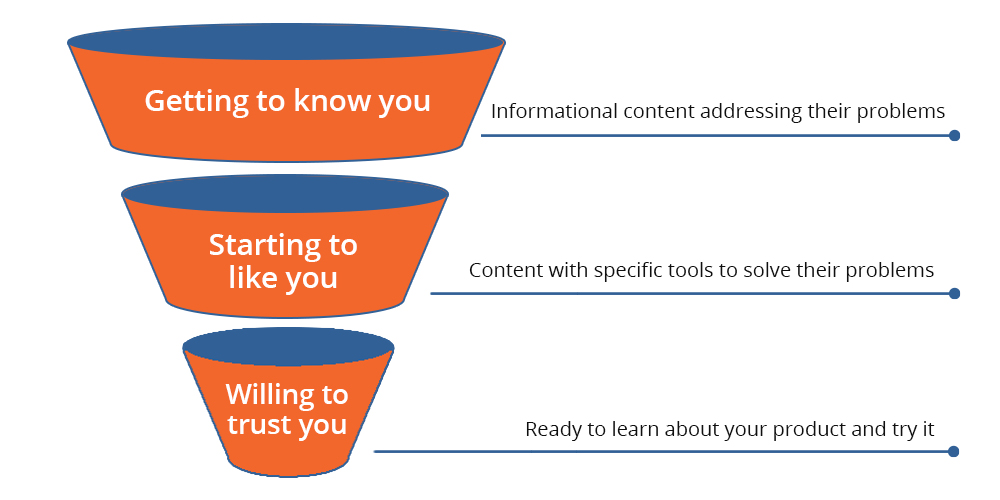
Many manufacturers are enamored with their own products, services and brands. They run ads in trade pubs with their logos and their products only.
But no one likes people who only talk about themselves — especially your prospects.
If your content addresses their problems first and provides some helpful tools (more on that in a second), they will get to know you and like you. Help them enough and they’ll trust you and eventually buy from you.
Here’s how you execute that concept through your content.
Getting to Know You: Top-of-the-funnel helpful information
Content description: Informative, focused on customer problems.
Content formats: Blog posts, videos, infographics, guest blogs, social media posts.
Goal: Add them to your newsletter list (email only), brand exposure, rank for semantic keywords.
To illustrate how this works, let’s say you are an aerospace parts manufacturer. You’ve just developed a new metal fabrication technique for airplane wings that reduces turbulence.
At the beginning of the customer journey, many airplane manufacturers aren’t aware of your new product, but they are dealing with issues of customer safety. They need to be kept aware of the big safety issues affecting their industry.
So we produce a piece of content to get on their radar — to get them to know us. It’s an article called “Top 10 Airplane Safety Features for Nervous Fliers.”

PATENT-PENDING PRO TIP: If you really want to get your content to be shared, integrate outside experts into the piece. Quote them, use their research and opinions — make it their words, not just yours. We call this “content collaboration.”
Starting to Like You: Mid-funnel tools
Content description: Interactive tools, solving problems related to your products and services.
Content formats: Downloadable charts, checklists, or online calculators. (White papers, yes, but ungate them unless you have proprietary research.)
Goal: Add them to your email list (with company info), LinkedIn connection.
You want someone in the manufacturing world to like you? Give ‘em a tool.
Our mid-funnel content is still focused on solving problems, but we want it to be specific to our products or services. Here are some examples of the types of downloadable tools that have proven effective for our clients:
- A builder has an online design tool that you can use to design and download building plans.
- A coating machine manufacturer produces a comparison chart for materials.
- A printer shows a checklist for reducing printing costs.
With our aerospace parts manufacturer, we’re going to provide them with a cost-analysis spreadsheet for balancing safety improvements with pricing increases.
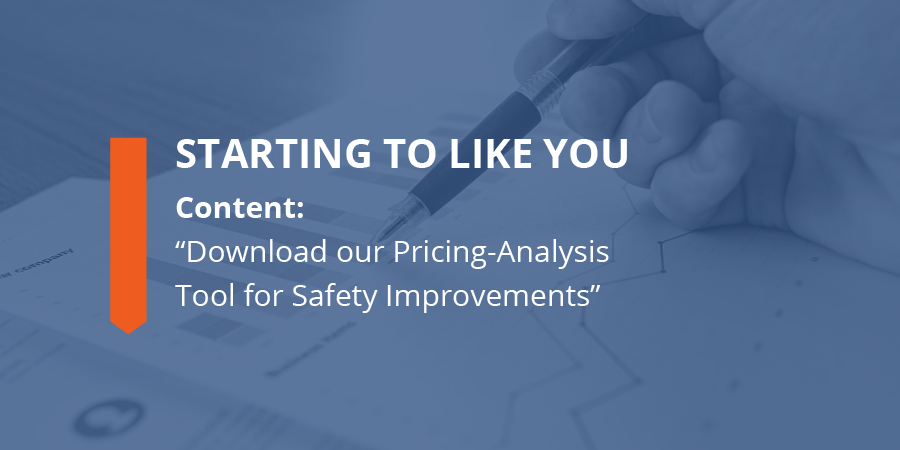
PATENT-PENDING PRO TIP: If (and when) you advertise in trade publications, these tools are exceptional performers in comparison to logo-centric brand ads. They also separate you from the other advertisers, who tend to just focus on their products and services.
Willing to Trust You: Buying stage
Content description: Products and services websites and collateral pages, social proof, links to case studies.
Content formats: Website pages.
Goal: Form submission with detailed company information, phone inquiries.
By this point, your customer knows you and they like you. You’ve helped them by doing a lot of fact-based research, and you’ve also given them a helpful tool. In return, they’ve subscribed to your email list, and Google now ranks your website pages because you have so much content.
Now people are willing to visit your website products and services pages. Now it’s time to get them to truly trust you. For our turbulence-reducing airplane wing, our webpage is packed with:
- Benefit-specific copy
- Data that backs your marketing claims
- Customer case studies and testimonials
Your call-to-action is to request a quote and set up a no-pressure discovery call on the part. The customer, who knows you, likes you and is now willing to trust you, signs up.
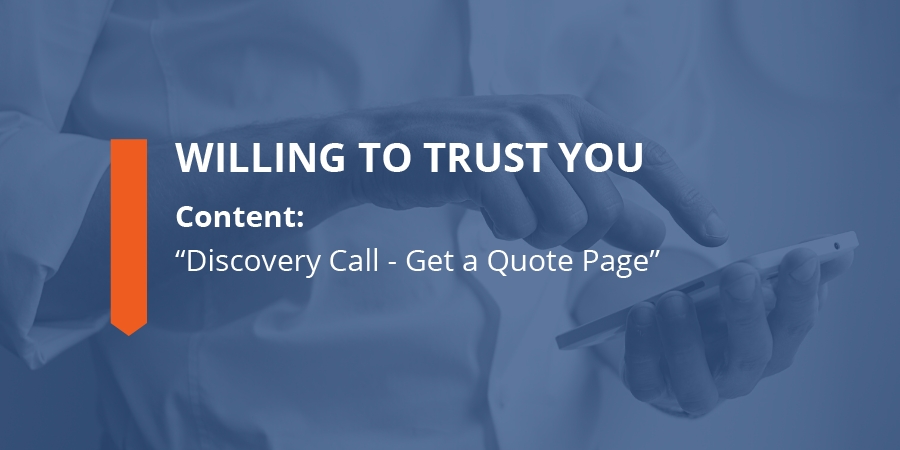
PATENT-PENDING PRO TIP: Case studies function extremely well as social proof. But you can also repurpose them into content, and even use them as ads. They will produce high conversion rates from prospects who are ready to purchase.
Understanding and creating content for each of these stages is important, but it’s mission critical that you can gauge the success of your efforts.

Part 4: SEO for Manufacturers: From Smoke and Mirrors to Clear-Cut Strategy
But SEO is based less on mysterious algorithms and website wizardry, and more on two simple concepts:

Relevance

Authority
Let’s start with a very straightforward overall explanation of how SEO works.
It’s just this simple: Relevance + Authority = #1 Ranking
To understand how SEO works, you have to start with the two main reasons people are using search engine browsers like Google or Bing:
1. They are searching for information.
2. They are searching to make a transaction.
Blog pages are structured to satisfy those informational, typically providing information and research. The tone is helpful, not sales-focused.
Product and Services pages are transactional in nature. They are designed for people who want to buy a product or sign up for a service. They are designed to close the sale.

Keywords = Relevance
Now each of these two types of pages will have keywords. When Google (we’ll use the #1 company used for search) reviews your pages, these keywords indicate what your page is about. This indicates Relevance to a particular subject on Google.
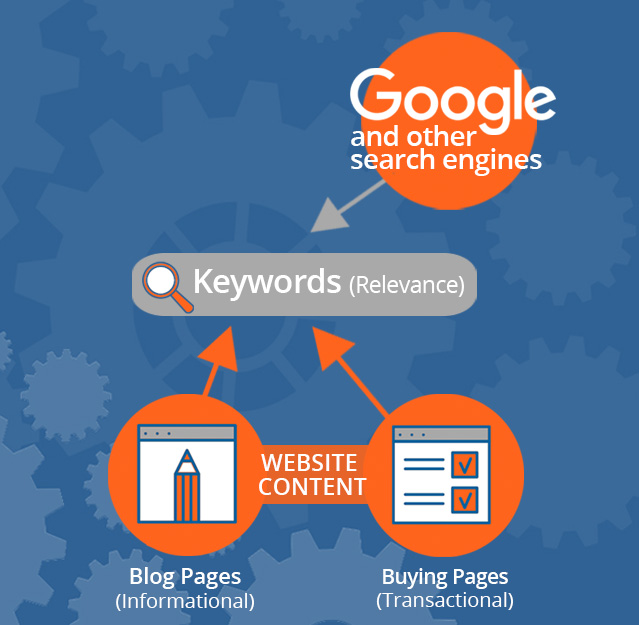
Your content can only have so much relevance in terms of keywords. In fact, if you overuse them on a page, that can indicate “keyword stuffing,” and Google will penalize you for this.
You should use keywords in a natural style, including “semantic” keywords, or other keywords related to the one you’re trying to rank for. There are some technical points here, which we’ll dive into in a bit, but essentially when you construct the page, you’ll build it to be relevant.
Backlinks = Authority
But relevance alone is not enough for Google to determine which website page should be ranked highest. For that, it needs some sort of signal from other websites that your website (and by proxy, you) is a reputable source for information.
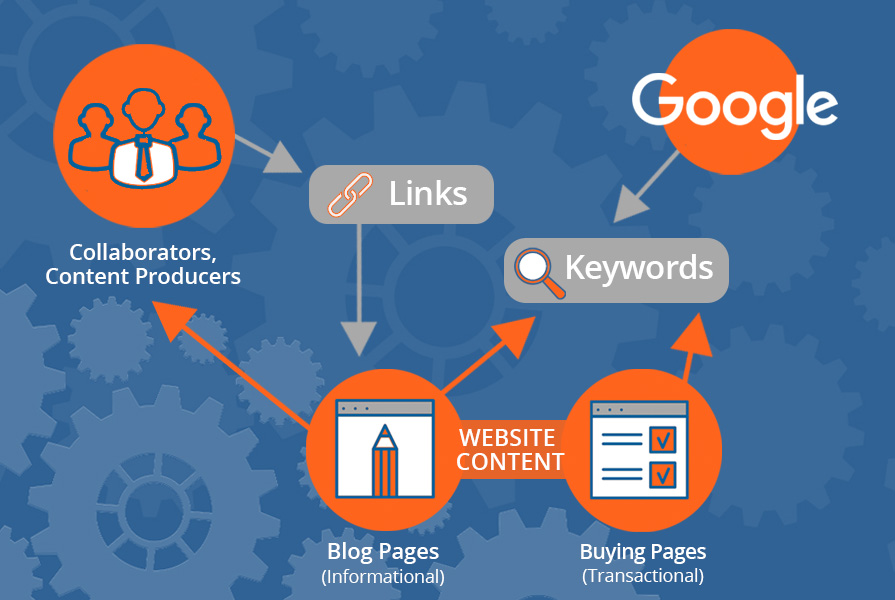
This occurs when other websites link to your page. For example, let’s say you publish an article on how to improve efficiency on the manufacturing floor. You’ve conducted research on the topic, and you have data that proves your point.
You publish the article, and notify other publishers via social media and direct contact about your findings. Eventually these other collaborators will mention your content in their own writings, and link to it on their websites because now you’re a source.
You’ve just received what is called a “backlink” to your site. Backlinks, or inbound links, indicate your site is an authoritative and trusted site.
Important:
People will link to informational articles as a reference source. But they won’t link to your product pages (and why should they?). That’s why informational pages are so valuable for SEO.
This is how you get ranked #1 on Google!
Now you’ve got both boxes checked off. You have Relevance and Authority. When Google sees relevant keywords and semantic keywords, and an abundance of links to your site, they will reward you and rank you #1!

That’s the overall concept of how SEO works. There are subtleties involved, including technical aspects, but if you understand this, you can build your content strategy.
And that leads us to…
How to rank for content in every stage of the customer journey
Remember the overall mindset behind creating the Digital Twin. You want people to know you, like you and trust you.
This lines up perfectly with your SEO strategy. You can create content that ranks for keywords in every stage of the customer journey. The end result: When people search for a topic, your “Digital Twin” is waiting for them!

Step #1: Conduct keyword research and build content for each stage of the customer journey.
Conduct your keyword research first, then build the content for the different stages. Always link from top of funnel pages (which tend to be your informational blog pages) to mid and bottom funnel pages (website product and services pages), passing along that “link juice” you’ll get from inbound links.

Step #2: Make sure each page is optimized
We’ve given you the broad strokes behind SEO. But you shouldn’t overlook the technical aspect of it.
Yes, your content needs to be delivered strategically, but there are some cues you’re going to pass along to Google to indicate relevance.
Title Tags and Meta-Descriptions: Your title tags may be the most important — and underestimated — part of your content creation. These indicate what will appear on the search engine results pages (SERPs).
It’s the first thing people see when they conduct a keyword search, much like an outside envelope in direct mail. Your goal is to get them to click through — here are some tips on optimizing for SERPs.
Content ready to be indexed: Using a tool like SEO Yoast, you can create an automatic site map of your website. This site map automatically notifies Google when new pages have been published.
(NOTE: If you’re creating a new page, you’ll want to alert Google’s Search Console that the page is ready for indexing. We do this with special pages. Your Google Analytics will need to be connected with Google’s Search Console to make this work.)
Use headlines and subheads, aka H1, H2 and H3 tags: Any good writer knows an article should include headlines and subheads. When people read on the Internet, they tend to skim, and these headers get them to the information they need quickly.
In the HTML code of the webpage, these headlines receive tags, such as “H1”. It’s a signal to the Google metacrawlers that this is an important line of text — a summary of sorts.
Think of your headlines as outlines of your overall article. Within this outline, you’ll want to use the keywords you’ve researched. Your most important keywords should be in the H1 headline — the main headline of the article.
Integrate semantic keywords throughout your article: Google encourages you to write for people, not for robots. What they’re encouraging you to do is not to game the system. They don’t want you to overstuff an article with keywords, for example, just to get a high ranking.
We’ve always written articles without worrying too much about keywords, because in the course of doing that, you’ll integrate “semantic” keywords. These are keywords that are related to the main topic.
If I was writing an article about headlines, for example, “subheads” would be a semantic keyword. Many of these will occur naturally through your writing, but you can look on Google’s “People also asked sections” on a search results page for other questions or phrases they use in a search.

Pro Tip:
Click on the down arrow (highlighted) in the “People also ask” box and Google will display more questions.

Step #3: Create links naturally
Why? Because sooner or later, those who control search engines don’t like marketers who try to game the system, and you’re one Google update away from losing your ranking.
Instead, we recommend focusing on the types of content that inspire links:
Original research. Andy Crestodina of Orbit Media has long made the case that original research inspires backlinks. Creating your own research can be a time and resource intensive process, but as he notes, the rewards can be amazing.
Strong opinion pieces. If you can craft a strong argument that will be cited by other writers, you’ve got a good chance at inspiring backlinks. This may be a tall order for manufacturers, but it’s an option.
Collaborative content. A slow and steady approach can be to integrate other experts and influencers into your articles. Your article has to be high quality, so the experts you’re featuring will link to it from their own site.
With manufacturers, we do this by writing articles about their suppliers and strategic partners. This not only extends your industry expertise, but it compels them to link to your page and share it through their social networks.
Guest posting. This is a great strategy, particularly for manufacturers in a defined niche. When you create a guest post on an industry news site, for example, you can link to your own content. You have to be careful you don’t keyword stuff on those inbound links, however. But guest posting has multiple benefits, including increased exposure for your business.
Link reclamation. You can also research the websites currently linking to your own site. If you find they are linking to incorrect pages (perhaps you want them to link to a specific page on your site), you can contact them to see if they’ll adjust the link.
All of these tactics (and there are many more) take time and effort. As a rule, we tend to focus on creating the kind of content that will inspire people to link to it. Once you do that, things happen naturally. They don’t call it organic traffic for nothing!
Have we demystified SEO?
Of course, there’s more to SEO than we’ve covered here. Like any subject, there is greater nuance and tactics that can be employed. But by and large, these are the fundamentals of SEO.
At Winbound, we’ve never been overly techie. We’re writers and communicators. We’ve always been writing for people, not computers.
However, once we understood the fundamentals of SEO and applied these techniques to our approach, we began achieving hundreds of page 1 rankings for our clients. You can do the same!
Part 5: Email Strategy for Your Manufacturing Marketing
No one loves their shiny, new objects like techie marketers. But for all the latest and greatest trends, there is no media that quite beats the workhorse that is email marketing.
It can work particularly well within our Digital Twin model because it’s one of the ways salespeople stay in touch with current customers and new prospects. Ultimately, it’s how you can transition people to the buying stage.
Before we get into the overall approach, let’s take a look at the main reason why email is one of the most trustworthy of manufacturing marketing tools.
Why email has stood the test of time
Email is one of our oldest digital tools, yet it remains one of the most effective. Like its offline cohort, direct mail, it continues to stand the test of time. Email marketing is both widely used and highly effective by B2B marketers. According to OptinMonster:
%
of B2B marketers cite email as their top channel for revenue
%
of B2B marketers find email to be the most successful channel for content distribution
Those are compelling stats. But here is a story that explains email’s staying power:
A woman who sold stamping materials was positively killing it on Facebook years ago. She’d spent a ton of time building a monstrous following, and her business was making money hand over fist.
Then Mark Zuckerberg looked at his business model, decided he’d given her a free ride long enough, and decided to change the Facebook algorithm. Suddenly her content was available to only 10% of her audience. She’d have to pay to boost it to the rest.
BLAM, just like that, her main source of marketing was taken away from her.
Why did this happen? Because the people who own the walled networks (Google, Facebook) control access to the users.
But with email marketing, that’s not the case. Why? Because YOU own the email list. The people who have given you those emails have done so willingly. Individuals can opt-out, sure, but no one is going to take them away in one fell swoop.
And when you have that list, you can do all types of things. The most noteworthy, of course, is marketing to the folks on it.
The biggest DON’T with email marketing
Before we get into email strategy, let’s talk about what you DON’T do with email marketing.
Don’t send an email to a person who hasn’t opted in to receive one – otherwise known as spamming.
Spamming emails is about the worst thing you can do for many reasons. The three most notable are:


Most people who receive it hate it. (Anecdotal, but please prove me wrong.)

It can mess with your deliverability and get your domain labeled a spammer.
In our post on how to do email marketing effectively, Jessica Best of Barkley explains just how easy it is to become labeled a “spammer.”
The threshold for being labeled a spammer is 0.1% of your email sends, so if you send to 10,000 people, all it takes is 10 people to call you SPAM before you’re treated like SPAM by inboxes like Google and Yahoo!
There are ways to do an outbound email marketing campaign in which you find out a person’s email address and reach out to them. But we don’t recommend it because, ultimately, it’s just not the smart way to build your brand.
From a receiver’s perspective, they can’t tell the difference between you and a spammer. And no matter how detailed and personalized we’ve made the emails, we’ve found the response rates low. (Yes, we’ve given it a try. Shhh!)
So how do you do email marketing and stay on the up and up?
The goal of your emails: To transition manufacturing customers to the buying phase
We’ve talked about the Know You, Like You, Trust You stages for the Digital Twin. Email serves as a transition point between these phases: Its goal is always to transition to the next stage in the customer journey.
Think of it as a salesperson reaching out to make a follow-up contact, and moving a prospect closer to the buying stage. With emails from our Digital Twin, we want that prospect to visit your website product and service pages and make a purchase.
Building your email list: What attracts subscribers, and how to get them to sign up
You can’t send anyone an email unless you get their email address, right? So let’s start with two key strategies for getting sign-ups.
There are myriad tactics you can use (we’ll link to some great ideas in a bit), but ultimately content will be the reason people will provide you with their email. The better your content, the more likely people will sign up to receive it.
People will give you their email address to receive content like the following:

1. Ongoing content
If someone has arrived at your top-of-funnel content via SEO, paid promotion, and/or social media, they hopefully will like it. And they’ll want more.
Give them an opportunity to get your content on an ongoing basis with a monthly or bi-monthly newsletter. (We’ll get into the newsletter in just a minute.)

2. Lead magnets (in-depth content, tools and templates)
Lead magnets are types of content that visitors to your website must submit an email to receive (sometimes referred to as “gated” content.) This tends to be middle-of-funnel content, when prospects are much closer to the buying phase.
Tools, templates and in-depth content such as white papers can be highly effective lead magnets. Here are some specific examples:


Delta ModTech created a chart comparing the types of coating methodologies that can be used in the converting process.


Wick Buildings created an interactive 3D Design tool for their post-frame buildings. Using the tool is free, but saving your plans requires an email address.


Winbound created an interactive checklist that includes everything you need to create a case study.
You can discover these types of tools both by talking to your customers as well as your sales team. Find out what tools people need to do their jobs more effectively.
You can also find ideas through keyword research. Look for terms involving “templates” and “checklists.”
Create an easy and compelling sign-up opportunity
You’ve got plenty of content-driven opportunities to create a sign-up. Now it’s time to close the deal. To do that, use highly visible sign-up opportunities, including:
Landing page with sign-up form: Create a specific landing page that promotes your lead magnet or monthly newsletter, and a simple form for sign-up. For newsletters, only require an email address. The less form fields, the higher the conversion rate.
Pop-up window: Install a form that will pop up on the screen after a reader is engaging in your
content. Set it to appear after 10–20 seconds, so you’re sure people are truly reading your content.
Sidebar and footer sign-up: You can also set the sidebar on your blog for sign-ups, but don’t forget about the footer. We’ve seen a high number of sign-ups from a good footer sign-up form.
Expert Tip:
What to include on your monthly newsletter sign-up form.
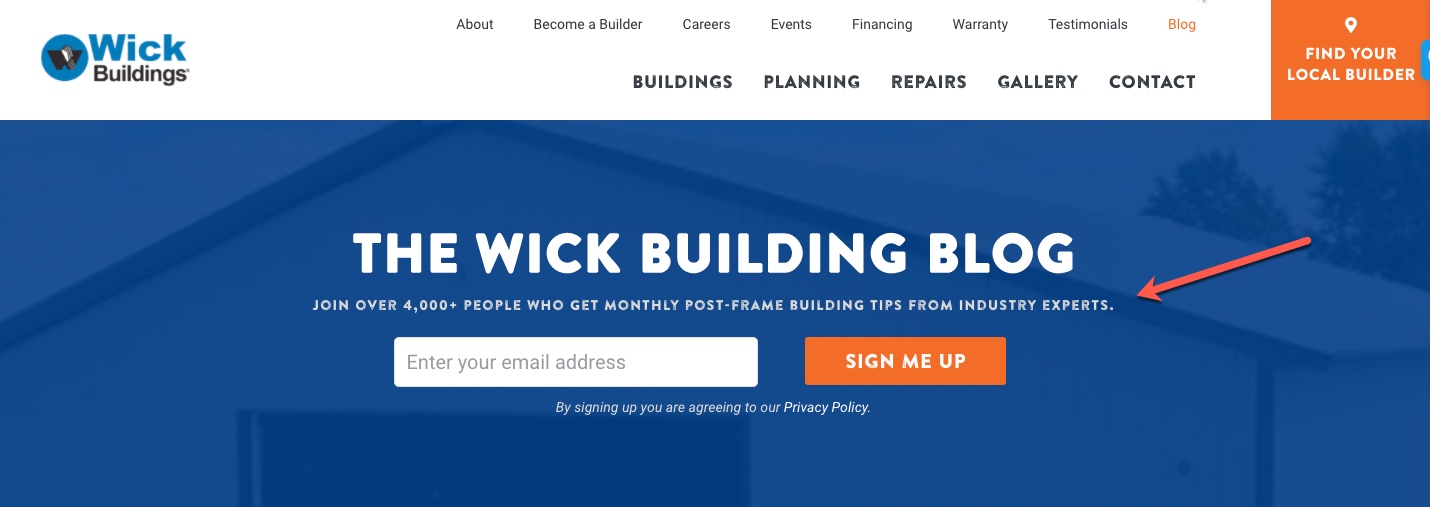
You really only need a short form for your newsletter. But don’t just throw out a “Subscribe to our monthly newsletter” message. Instead, include:
- What type of content is included in the newsletter
- Specify how often you’ll be sending it
- Include some form of social proof to compel sign-ups
We’ll get into the specifics of what that newsletter should look like and how to market it in a bit. But first, let’s dive into the lead nurturing emails you will send out for that mid-funnel content.
Types of emails to send: Lead Nurturing, the Monthly eNewsletter, and Email Blasts
There are all kinds of emails you can send. In our Digital Twin approach, we’re attempting to recreate the goals and activities of your top manufacturing salesperson, and what types of emails they’d send.
In our approach, we’ll use email in three different ways, all designed to get prospects to trust you and transition to the buying stage:

1. Lead Nurturing:
Introduce your company and showcase your success

2. Monthly eNewsletter:
Stay in front of customers and prospects

3. Email Blasts:
Announce new products or services
1. Lead Nurturing: Introduce your company and showcase your manufacturing success
You’ve probably heard of a “drip email” sequence, or email lead nurturing. This is a series of emails to be delivered to the prospect immediately after they’ve downloaded the mid-funnel content.
Before we get into the approach, remember these important tips:
Let them know what’s coming. On the sign-up page for your product, make sure you specify that you’ll be sending a series of emails with some more information on your company. This will reduce your unsubscribe rate, and it’s good practice to let people know what’s coming (and in compliance with email laws).
Keep your emails short, and link to a webpage. No one likes a long email. Keep these short, with just enough information to make them want to learn more. Then link them to the website, which is really where you want them to go.
Ok, here’s a recommended sequence.
Email #1:
Welcome them and introduce your company. People like doing business with people. So use this opportunity to introduce yourself and give a brief overview of your company. Link to your “about” page.
Email #2:
Case studies. Remember, you’re out to establish trust. And nothing builds trust like your case studies. Use 1 or 2 emails to let the customer success tell your tale.
Link to your case studies.

Email #3:
Explain your products and services pages. Now that you’ve built up your reputation and established some social proof with your case studies, you can roll out your products or your services. If possible, keep things at a high level, and invite them to drill down into your product pages for more specs and testimonials.
Link to your product and service pages.

Email #4:
Remind them of the monthly newsletter. Remember on the sign-up form, we specify that you’ll be sending 4 emails. You may also want to say that includes an automatic subscription to the eNewsletter, and be sure to reinforce its value.
In this email, your sequence is done, so you want to include a transition to an email to keep you in front of your prospects. Let them know you’ll be sending them your monthly newsletter, and include some links to sample posts. (Remind them they can unsubscribe at any time.)
Link to top blog posts.
Do these really work? Heck yeah!
Remember, these folks just downloaded a great piece of content from you, and they’re eager to learn more about you. That’s why these emails typically have such high open rates. This client’s sequence is a slight variation from above, but look at the high open rates for the emails.
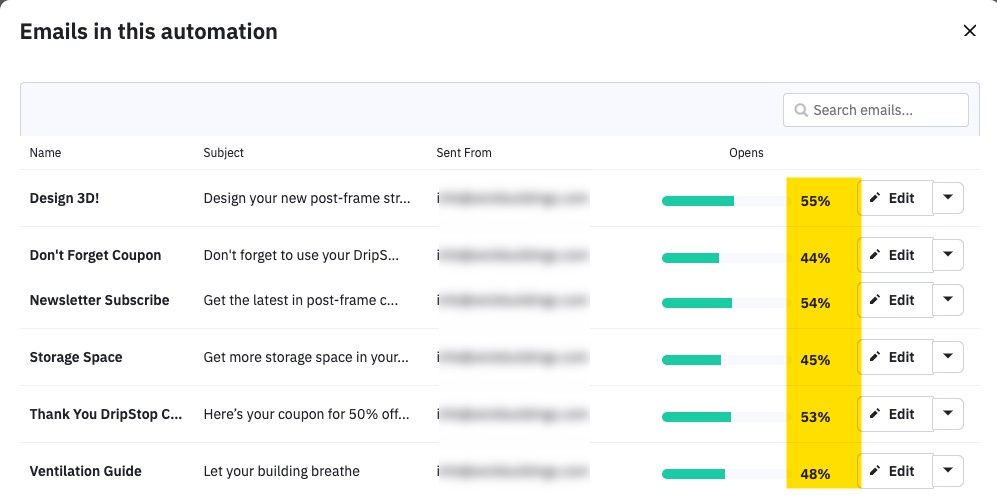
According to SuperOffice, the average open rate for emails was 22.1% in 2019, so these open rates are almost double the standard.
Expert Tip:
Set the timing on your follow-up emails to one per day
While some marketers like to spread out their lead nurturing emails, we agree with the words of Gini Dietrich of Spin Sucks who advocates sending out your lead nurturing emails immediately after the conversion:
2. The Monthly eNewsletter: Stay in front of customers and prospects
All manufacturers have a long sales cycle. You know you have to stay in front of prospects so when they’re ready to act, you’re top of mind. And just as important, you want to stay in front of current customers, and let them know about new products and services.
A monthly eNewsletter will keep you in front of them, month after month, and showcase your insights, new products, and case studies. It’s the tool that keeps on selling for you.
We are big fans of the regular newsletter, and we’re not alone. In fact, 77% of B2B companies use an email marketing newsletter as part of their content marketing strategy. Here’s how to get it done:
Use the ongoing content you’re creating
Think about the newsletters that you subscribe to and read often. You value them – heck, you may even rely on them for quality information. That’s our goal. To build a similar, compelling newsletter.
So now, the next question is … what will you put in the newsletter?
Marketers always cringe at the thought of a newsletter. It can be such a Herculean effort to put one together on a regular basis, right?
Wrong.
If you’re creating content on an ongoing basis, you’re writing your newsletter with each new piece. It’s very simple to collect that top-of-funnel content at the end of the month and package it into a newsletter.
But now we get to the most important part: Creating the type of content that will compel people to subscribe, and then keep them subscribed.
Make sure that content is timely and/or niche-focused
Prospects today are more wary of giving up their email. And you should respect that.
So if you’re going to build your list, you have to give them something that’s worth subscribing to. Provide them with a newsletter that meets either of the following criteria or, ideally, both:
![]() Timely. People will subscribe to your newsletter list only if there is something they want to see, month after month. For example, if you are a manufacturer, you may want to publish timely information, such as ongoing updates of monthly industry sales.
Timely. People will subscribe to your newsletter list only if there is something they want to see, month after month. For example, if you are a manufacturer, you may want to publish timely information, such as ongoing updates of monthly industry sales.
 Niche-focused. If you’re marketing to a niche – like we specialize in marketing materials for small manufacturing market departments – you’re producing content that’s specific to what your prospects need. The less generic it is, the more likely they’ll subscribe.
Niche-focused. If you’re marketing to a niche – like we specialize in marketing materials for small manufacturing market departments – you’re producing content that’s specific to what your prospects need. The less generic it is, the more likely they’ll subscribe.
If you’ve followed your marketing plan, your content should already be niche-focused. Adding in some time-based element will give your newsletter extra appeal.
ESSENTIAL:
Keep publishing consistently.
The one thing you don’t want to do is become inconsistent with your newsletter. By staying in front of your prospects, month after month, you’re there the moment they finally decide to take action.
Yes, you can sell from your newsletter
People subscribed to your newsletter for more top-of-funnel content. But that doesn’t mean you can’t include some promotional content in it as well.
Deliver on the promise of what the newsletter will deliver (exceptional monthly content), but you can also feature a new product or service in the introduction section of your newsletter. You also want to highlight case studies and events, such as webinars or coaching sessions.
3. Email Blasts: Announce new products or services
Use one-off email blasts sparingly for new product updates and announcements. Get too pushy with products and people will unsubscribe. We tend to keep most product announcements in the intro of the newsletter, but use the email blasts to really make a splash.
You can also use these for disruptions in service. Many clients sent out special COVID-19 emails, for example, to alert customers of new hours or office procedures.
Sure, there’s more that can be done, but start here
Note that these approaches are designed for small marketing teams, and don’t involve the in-depth sophistication that includes lead scoring or extensive automation. You can always build out the strategy as you see more success and you’re awarded more resources by management.
The tactics above, however, will help you achieve a consistent and manageable email marketing approach. It’s the ideal foundation for your Digital Twin’s email marketing.

Part 6: Measuring Marketing Effectiveness: Your Digital Twin’s Review
Peter Drucker once said, “You can’t manage what you can’t measure.”
This is entirely true. It’s also not entirely easy. In fact, marketing departments typically find themselves overwhelmed by the endless amounts of data made available by tools like Google Analytics and SEMrush.
The key to all of these factors is to consider an approach taken by analytics guru Avinash Kaushik. He recommends focusing on “the critical few” metrics — the ones that really determine your success.
The Digital Twin’s “critical few”: Traffic and conversions
Much like the salesperson is measured in terms of activity and deals, we measure the success of our content marketing by two critical metrics:

Traffic
Did it go up or go down?

Conversions
Did it go up or go down throughout the sales funnel?
Our reports are about twenty pages in length. We take about two pages to share our critical few numbers, traffic and conversions.
Then we take about 18 pages to analyze them, with the goal of answering two simple questions:
Did the number go up or down? (easy)
Why or why not? (hard)
Digging deep into these numbers can unearth the truth. For example:
Ranking for the wrong keywords: At first glance, your traffic might be skyrocketing. But as you dig deeper, you may find that you are ranking for search terms that jack up your number, but aren’t in your targeted keywords. We once ranked for the name of a somewhat obscure actor — Kenneth Logran. He drove 33% of the traffic to the site — not exactly what we were looking for!
Having low traffic but high conversions: There is a knee-jerk reaction to high traffic, but we’ve generated great success for customers by generating lower number of quality visits, which result in higher conversion rates.
In any case, the metrics you set can be wide-ranging (we include some typical KPIs below), but it’s really the analysis that makes the difference and reveals whether you’re having true success.
What to include in your KPIs?
We’ve told you about our critical few, but we are able to answer those questions by examining a number of Key Performance Indicators (KPIs).
We don’t necessarily present these in our reports, but they do shape our analysis. And, based on your overall goals, you may consider one or two of these to be part of your critical few.

We’re not just talking about traffic counts, which far too often are considered a measure of success. We want the right traffic, which for most B2B marketers includes visits from decision-makers in a director role.
You can get that kind of occupation-specific data with a LinkedIn tool called Website Demographics. This is a game-changer for B2B marketers.
Simply install the pixel on your website, and LinkedIn will provide you with a breakdown of the types of visitors coming to your site (job title, company demographics).
It won’t give you the individual profiles, but the aggregate data can help you determine if you’re producing the right content for the right people.

You want to start building a list of the people you’ve attracted with the content. Your metric here would include conversions such as sign-ups for white papers and downloadable tools.
You can also measure email drip campaigns that you send to these lists to gauge success in moving prospects to KPI #3.

Once you have a prospect that either calls in or submits a form to speak to someone at your company, your marketing department can qualify the lead.
Is the prospect coming from the right company, with the right job title? Is the marketing producing the types of leads you can pass along to your sales team for follow-up?

You’ve passed along the marketing-qualified leads to the sales team. Now you’re going to track how many of those leads the sales team follows up with a discovery call and then actually enters into their pipeline.
This is a bit subjective. You may want to just make this about deals closed by the sales team, assuming that, if it’s a marketing-qualified lead, the sales team will follow up.

Huh? What? Isn’t branding a smoke-and-mirrors tactic of the bygone Mad Men days?
Actually, no, and there’s data to prove it. Market research conducted by Binet and Field found that when companies spend more on branding campaigns than they do on lead generation, they actually have better results.
For B2B spending, the spending split is becoming almost 50-50 lead gen and branding.
Measuring brand has always been a challenge for organizations. You can use brand research surveys, which have proven effective in the past. One simple metric which might provide some insight is your “branded search” traffic volume. (Here’s more on branded search.)
PRO TIP: Don’t just note the percentage value of your overall traffic of branded search. You want to track the overall numbers to see if they are trending up.

This one is a bit fuzzy, but it’s relevant when considering the cross-functional impact marketing can have.
For example, a client of ours asked us to produce content that would help streamline their customer education process. Instead of their then-current hour-long, one-on-one meetings, they wanted video and written content that the customer could absorb at their own pace.
It’s an example of how marketing can both improve the customer experience and make an organization more efficient.
Work with the client to determine the metrics for this type of business value. Let them brainstorm the right numbers to track. They will then have ownership and understand the business value you provide.
Keep your short-term results to drive long-term success
Managing your metrics can be tricky business. You’ll likely be overwhelmed by data, and some of it isn’t always accurate. (We can tell you a few horror stories about how misleading data reported by third-party vendors caused unnecessary grey hairs and sleepless nights.)
However, you need something to gauge the success of your Digital Twin. The key is to react, but not over-react. Pivot in areas where you see real, proven downturn (a direct cause and effect), but stay true to your vision and strategy.
Success in the digital world is like branding of old: It takes time, effort and lots of exposure. Keep your eyes on the prize.

Part 7: Managing a Manufacturing Marketing Department: It Takes a Village to Raise a Digital Twin
If you’re nodding your head like the Digital Twin concept seems right for your manufacturing company, you may also have a sinking feeling if you’re managing a small marketing team.
Sounds great, you’re thinking. But you really don’t believe it’s possible because:
Strategically, you’re feeling overwhelmed. Every day, it seems like a new digital platform or strategy emerges. And because there are so many potential directions you could go with your approach, it’s hard to figure out what’s the right one.
Operationally, you’re stretched for resources. If you’re like most marketers, you either lead or you’re part of a 1—3 person marketing team. You’re being asked to cover a lot of ground with limited resources.
Personally, you’re a generalist in a time that also requires specialists. You have a broad understanding of multiple areas of marketing, and perhaps you’re really good at a particular area (analysis, design, writing), but you don’t have the time to become an expert in all the areas.
It’s not easy to pull this off. But building your own team likely isn’t a realistic scenario.
To that end, let’s assume you’re going to build up your marketing team by filling the following positions and paying the accompanying average annual salaries (based on data from The Creative Group 2020 Salary Guide).

Add all those annual salaries up and divide by 12, and you’ll see that in one month you’ll be paying about $31,000 in total salaries for that top-notch team.
So how do you shape your marketing department?
Division of labor for a manufacturing marketing team: Generalists vs. specialists
Let’s face facts: Most marketing directors of small marketing teams are generalists. They have to be — there are simply too many things to get done to take a deep dive into a 2,500 word blog post or 20 pages of metrics analysis.
The key to any manufacturing is a division of labor, so divide your workload accordingly:
Top marketing activities to perform in house
You’ll make smarter outsourcing decisions when you pinpoint what really makes sense to handle in house, such as:

- Responsibilities that demand vision and leadership of your department’s mission
- Specific internal domains like your budget and overall strategy
- Frequent, routine tasks that are important but don’t require a specialized skill set
- Activities that need an onsite presence
Top marketing activities to outsource
Outsourced activities generally fall into three buckets:

- Responsibilities that demand specialized knowledge related to the latest tactics and technology
- Tasks that aren’t office dependent and can easily be accomplished off-site
- Temporary activities that don’t necessarily require hiring an employee
In working with many small marketing departments, we think you can break this down into two key areas:
You should be a specialist in your company, products / services and industry.
You should be a generalist in marketing strategies, tactics and tools.
Break it down into those two areas, in house the former, outsource the latter, and you can make the Digital Twin come to life.
Next Steps: Start Talking
You know the challenges. You know the direction the market is headed. Now you need to start…talking?
Yes, talking.
Talk to your leadership team about making a commitment to creating the Digital Twin, and synchronizing your marketing and sales units.
Talk to your sales team and really find out what they do and how you can support them.
Talk to your customers to truly understand how they shop, where they want to consult the Digital Twin, and when they want the real person.
And, finally…
Talk to us if you want to learn more about how Winbound can help you create a Digital Twin of your sales team.
Subscribe and get all our assessment tools!
Subscribe to our monthly newsletter for sales and marketing insights, and you’ll also get access to all our research, checklists and how-to guides to help you assess your own efforts.
By submitting this form you agree to our Privacy Policy.
625 N Segoe Rd #701
Madison, WI 53705

